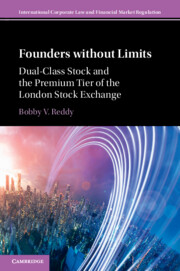Book contents
- Founders without Limits
- Cambridge University Press
- Founders without Limits
- Copyright page
- Contents
- Figures
- Tables
- Preface
- Acknowledgements
- Table of Cases
- Table of Legislation and Regulation
- Abbreviations
- Introduction
- Part I Putting Dual-Class Stock into Context
- 1 The Cult of Dual-Class Stock in the Era of Big Tech
- 2 A Tale of Two Cities and Beyond
- 3 First among Equals?
- 4 Shareholder Democracy and Corporate Purpose
- Part II Evaluating Dual-Class Stock
- Part III Formulating a Policy on Dual-Class Stock
- Appendix Comparison of Inferior-Voting Shareholder Protections on Major Dual-Class Stock Exchanges
- Index
2 - A Tale of Two Cities and Beyond
from Part I - Putting Dual-Class Stock into Context
Published online by Cambridge University Press: 29 October 2021
- Founders without Limits
- Cambridge University Press
- Founders without Limits
- Copyright page
- Contents
- Figures
- Tables
- Preface
- Acknowledgements
- Table of Cases
- Table of Legislation and Regulation
- Abbreviations
- Introduction
- Part I Putting Dual-Class Stock into Context
- 1 The Cult of Dual-Class Stock in the Era of Big Tech
- 2 A Tale of Two Cities and Beyond
- 3 First among Equals?
- 4 Shareholder Democracy and Corporate Purpose
- Part II Evaluating Dual-Class Stock
- Part III Formulating a Policy on Dual-Class Stock
- Appendix Comparison of Inferior-Voting Shareholder Protections on Major Dual-Class Stock Exchanges
- Index
Summary
Chapter 2 details the history of dual-class stock.Although dual-class stock was commonplace in the United Kingdom in the 1950s-1960s, they had all but died a death by the early 1990s.The underlying influence of institutional shareholders, the principal players on the market, has been apposite, culminating in the FCA’s eventual formal premium tier prohibition of dual-class stock.In contrast, the NYSE, in the 1980s, when institutional investors had less of an influence in the United States, with substantial pressure from large issuers and competing local exchanges, ushered in a largely permissive environment for dual-class stock, after an erstwhile prohibition of the structure. The United Kingdom and the United States have been influenced by the dominant players on the market at the time.In recent years, Hong Kong, Singapore, Tokyo, Shanghai and India, in response to increased global competition, all opened-up to dual-class stock, but with prescriptive mandatory conditions attached to protect public shareholders.Mainland Europe, on the other hand, presents a diverse array of approaches to dual-class stock.The dual-class stock story around the world has not yet been concluded, and as the United Kingdom begins to consider dual-class stock once again, a detailed assessment of the merits of dual-class structure is long overdue.
Keywords
- Type
- Chapter
- Information
- Founders without LimitsDual-Class Stock and the Premium Tier of the London Stock Exchange, pp. 70 - 118Publisher: Cambridge University PressPrint publication year: 2021



